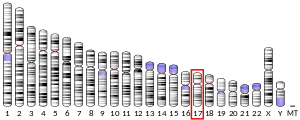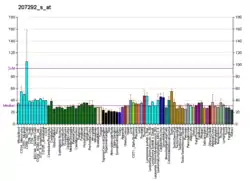MAPK7
Mitogen-activated protein kinase 7 also known as MAP kinase 7 is an enzyme that in humans is encoded by the MAPK7 gene.[5][6]
Function
MAPK7 is a member of the MAP kinase family. MAP kinases act as an integration point for multiple biochemical signals, and are involved in a wide variety of cellular processes such as proliferation, differentiation, transcription regulation and development. This kinase is specifically activated by mitogen-activated protein kinase kinase 5 (MAP2K5/MEK5). It is involved in the downstream signaling processes of various receptor molecules including receptor tyrosine kinases, and G protein-coupled receptors. In response to extracellular signals, this kinase translocates to the cell nucleus, where it regulates gene expression by phosphorylating, and activating different transcription factors. Four alternatively spliced transcript variants of this gene encoding two distinct isoforms have been reported.[7]
MAPK7 is also critical for cardiovascular development [8] and is essential for endothelial cell function.[9][10]
Interactions
MAPK7 has been shown to interact with:
References
- GRCh38: Ensembl release 89: ENSG00000166484 - Ensembl, May 2017
- GRCm38: Ensembl release 89: ENSMUSG00000001034 - Ensembl, May 2017
- "Human PubMed Reference:". National Center for Biotechnology Information, U.S. National Library of Medicine.
- "Mouse PubMed Reference:". National Center for Biotechnology Information, U.S. National Library of Medicine.
- Purandare SM, Lee JD, Patel PI (March 1999). "Assignment of big MAP kinase (PRKM7) to human chromosome 17 band p11.2 with somatic cell hybrids". Cytogenet. Cell Genet. 83 (3–4): 258–9. doi:10.1159/000015199. PMID 10072598. S2CID 31186896.
- Zhou G, Bao ZQ, Dixon JE (Jun 1995). "Components of a new human protein kinase signal transduction pathway". J. Biol. Chem. 270 (21): 12665–9. doi:10.1074/jbc.270.21.12665. PMID 7759517.
- "Entrez Gene: MAPK7 mitogen-activated protein kinase 7".
- Hayashi M, Lee JD (Oct 2004). "Role of the BMK1/ERK5 signaling pathway: lessons from knockout mice". J. Mol. Med. 82 (12): 800–8. doi:10.1007/s00109-004-0602-8. PMID 15517128. S2CID 8499230.
- Roberts OL, Holmes K, Müller J, Cross DA, Cross MJ (Dec 2009). "ERK5 and the regulation of endothelial cell function". Biochem. Soc. Trans. 37 (Pt 6): 1254–9. doi:10.1042/BST0371254. PMID 19909257.
- Roberts OL, Holmes K, Müller J, Cross DA, Cross MJ (Sep 2010). "ERK5 is required for VEGF-mediated survival and tubular morphogenesis of primary human microvascular endothelial cells". J. Cell Sci. 123 (Pt 18): 3189–200. doi:10.1242/jcs.072801. PMID 20736307.
- English JM, Pearson G, Hockenberry T, Shivakumar L, White MA, Cobb MH (Oct 1999). "Contribution of the ERK5/MEK5 pathway to Ras/Raf signaling and growth control". J. Biol. Chem. 274 (44): 31588–92. doi:10.1074/jbc.274.44.31588. PMID 10531364.
- Cameron SJ, Malik S, Akaike M, Lerner-Marmarosh N, Yan C, Lee JD, Abe J, Yang J (May 2003). "Regulation of epidermal growth factor-induced connexin 43 gap junction communication by big mitogen-activated protein kinase1/ERK5 but not ERK1/2 kinase activation". J. Biol. Chem. 278 (20): 18682–8. doi:10.1074/jbc.M213283200. PMID 12637502.
- Yang CC, Ornatsky OI, McDermott JC, Cruz TF, Prody CA (Oct 1998). "Interaction of myocyte enhancer factor 2 (MEF2) with a mitogen-activated protein kinase, ERK5/BMK1". Nucleic Acids Res. 26 (20): 4771–7. doi:10.1093/nar/26.20.4771. PMC 147902. PMID 9753748.
- Buschbeck M, Eickhoff J, Sommer MN, Ullrich A (Aug 2002). "Phosphotyrosine-specific phosphatase PTP-SL regulates the ERK5 signaling pathway". J. Biol. Chem. 277 (33): 29503–9. doi:10.1074/jbc.M202149200. PMID 12042304.
- Hayashi M, Tapping RI, Chao TH, Lo JF, King CC, Yang Y, Lee JD (Mar 2001). "BMK1 mediates growth factor-induced cell proliferation through direct cellular activation of serum and glucocorticoid-inducible kinase". J. Biol. Chem. 276 (12): 8631–4. doi:10.1074/jbc.C000838200. PMID 11254654.
- Zheng Q, Yin G, Yan C, Cavet M, Berk BC (Mar 2004). "14-3-3beta binds to big mitogen-activated protein kinase 1 (BMK1/ERK5) and regulates BMK1 function". J. Biol. Chem. 279 (10): 8787–91. doi:10.1074/jbc.M310212200. PMID 14679215.
Further reading
- Lee JD, Ulevitch RJ, Han J (1995). "Primary structure of BMK1: a new mammalian map kinase". Biochem. Biophys. Res. Commun. 213 (2): 715–24. doi:10.1006/bbrc.1995.2189. PMID 7646528.
- Warn-Cramer BJ, Lampe PD, Kurata WE, Kanemitsu MY, Loo LW, Eckhart W, Lau AF (1996). "Characterization of the mitogen-activated protein kinase phosphorylation sites on the connexin-43 gap junction protein". J. Biol. Chem. 271 (7): 3779–86. doi:10.1074/jbc.271.7.3779. PMID 8631994.
- Kato Y, Kravchenko VV, Tapping RI, Han J, Ulevitch RJ, Lee JD (1997). "BMK1/ERK5 regulates serum-induced early gene expression through transcription factor MEF2C". EMBO J. 16 (23): 7054–66. doi:10.1093/emboj/16.23.7054. PMC 1170308. PMID 9384584.
- English JM, Pearson G, Baer R, Cobb MH (1998). "Identification of substrates and regulators of the mitogen-activated protein kinase ERK5 using chimeric protein kinases". J. Biol. Chem. 273 (7): 3854–60. doi:10.1074/jbc.273.7.3854. PMID 9461566.
- Grunwald ME, Yu WP, Yu HH, Yau KW (1998). "Identification of a domain on the beta-subunit of the rod cGMP-gated cation channel that mediates inhibition by calcium-calmodulin". J. Biol. Chem. 273 (15): 9148–57. doi:10.1074/jbc.273.15.9148. PMID 9535905.
- Warn-Cramer BJ, Cottrell GT, Burt JM, Lau AF (1998). "Regulation of connexin-43 gap junctional intercellular communication by mitogen-activated protein kinase". J. Biol. Chem. 273 (15): 9188–96. doi:10.1074/jbc.273.15.9188. PMID 9535909.
- Yang CC, Ornatsky OI, McDermott JC, Cruz TF, Prody CA (1998). "Interaction of myocyte enhancer factor 2 (MEF2) with a mitogen-activated protein kinase, ERK5/BMK1". Nucleic Acids Res. 26 (20): 4771–7. doi:10.1093/nar/26.20.4771. PMC 147902. PMID 9753748.
- Kato Y, Tapping RI, Huang S, Watson MH, Ulevitch RJ, Lee JD (1998). "Bmk1/Erk5 is required for cell proliferation induced by epidermal growth factor". Nature. 395 (6703): 713–6. doi:10.1038/27234. PMID 9790194. S2CID 204997780.
- Zhao M, New L, Kravchenko VV, Kato Y, Gram H, di Padova F, Olson EN, Ulevitch RJ, Han J (1999). "Regulation of the MEF2 family of transcription factors by p38". Mol. Cell. Biol. 19 (1): 21–30. doi:10.1128/mcb.19.1.21. PMC 83862. PMID 9858528.
- Kamakura S, Moriguchi T, Nishida E (1999). "Activation of the protein kinase ERK5/BMK1 by receptor tyrosine kinases. Identification and characterization of a signaling pathway to the nucleus". J. Biol. Chem. 274 (37): 26563–71. doi:10.1074/jbc.274.37.26563. PMID 10473620.
- English JM, Pearson G, Hockenberry T, Shivakumar L, White MA, Cobb MH (1999). "Contribution of the ERK5/MEK5 pathway to Ras/Raf signaling and growth control". J. Biol. Chem. 274 (44): 31588–92. doi:10.1074/jbc.274.44.31588. PMID 10531364.
- Fukuhara S, Marinissen MJ, Chiariello M, Gutkind JS (2000). "Signaling from G protein-coupled receptors to ERK5/Big MAPK 1 involves Galpha q and Galpha 12/13 families of heterotrimeric G proteins. Evidence for the existence of a novel Ras AND Rho-independent pathway". J. Biol. Chem. 275 (28): 21730–6. doi:10.1074/jbc.M002410200. PMID 10781600.
- Kato Y, Zhao M, Morikawa A, Sugiyama T, Chakravortty D, Koide N, Yoshida T, Tapping RI, Yang Y, Yokochi T, Lee JD (2000). "Big mitogen-activated kinase regulates multiple members of the MEF2 protein family". J. Biol. Chem. 275 (24): 18534–40. doi:10.1074/jbc.M001573200. PMID 10849446.
- Yan C, Luo H, Lee JD, Abe J, Berk BC (2001). "Molecular cloning of mouse ERK5/BMK1 splice variants and characterization of ERK5 functional domains". J. Biol. Chem. 276 (14): 10870–8. doi:10.1074/jbc.M009286200. PMID 11139578.
- Hayashi M, Tapping RI, Chao TH, Lo JF, King CC, Yang Y, Lee JD (2001). "BMK1 mediates growth factor-induced cell proliferation through direct cellular activation of serum and glucocorticoid-inducible kinase". J. Biol. Chem. 276 (12): 8631–4. doi:10.1074/jbc.C000838200. PMID 11254654.
- Dong F, Gutkind JS, Larner AC (2001). "Granulocyte colony-stimulating factor induces ERK5 activation, which is differentially regulated by protein-tyrosine kinases and protein kinase C. Regulation of cell proliferation and survival". J. Biol. Chem. 276 (14): 10811–6. doi:10.1074/jbc.M008748200. PMID 11278431.
- Watson FL, Heerssen HM, Bhattacharyya A, Klesse L, Lin MZ, Segal RA (2001). "Neurotrophins use the Erk5 pathway to mediate a retrograde survival response". Nat. Neurosci. 4 (10): 981–8. doi:10.1038/nn720. PMID 11544482. S2CID 3164934.
- Esparís-Ogando A, Díaz-Rodríguez E, Montero JC, Yuste L, Crespo P, Pandiella A (2002). "Erk5 participates in neuregulin signal transduction and is constitutively active in breast cancer cells overexpressing ErbB2". Mol. Cell. Biol. 22 (1): 270–85. doi:10.1128/MCB.22.1.270-285.2002. PMC 134212. PMID 11739740.





